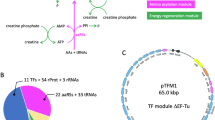Abstract
The cell-free protein biosynthesis has the potential to become a powerful technology for the biochemical research in particular in the determination of the structure and function of proteins. The number of possible applications is rising with the obtainable yields and with the expanded feasibility of introducing modified amino acids into proteins. Here we describe the influence of two RNA translation components, the mRNA and the suppressor tRNA, on the efficiency of protein biosynthesis.
It is shown that the rate limiting factor of the cell-free translation of the two proteins dihydrofolate reductase (DHFR) and fatty acid binding protein (FABP) is not the initiation or termination step. The efficiency of peptide bond formation in the nascent protein varies between the two genes but is independent on the size of the coding sequences. The poor translation of DHFR can be improved when its coding sequence is fused with a part of the more efficiently translated FABP gene.
We compared different amber suppressor tRNAs on the level of translational efficiency and aminoacylation capacity. Our results show that in most cases the aminoacylation rate of the tRNAs is not the limiting factor of suppression. An E. coli tRNALeuCUA exhibits the highest translational efficiency of the examined tRNAs. So this tRNALeuCUA may be a starting point to construct more efficient tRNAs for the introduction of unnatural amino acids into proteins in the in vitro translation system by eliminating the synthetase mediated aminoacylation of the tRNA.
Access this chapter
Tax calculation will be finalised at checkout
Purchases are for personal use only
Preview
Unable to display preview. Download preview PDF.
Similar content being viewed by others
References
Cronenberger, J.H. and Erdmann, V.A. (1975). Stimulation of polypeptide polymerization by blocking of free sulphydryl groups in Escherichia coli ribosomal proteins. J. Mol. Biol. 95, 125–137
De Smit M.H. and Van Duin J. (1990). Control of prokaryotic translational initiation by mRNA secondary structure. Progr. Nucl. Acid Res. Mol. Biol. 38, 1–35
Fuchs, U., Stiege, W., Erdmann, V.A. (1997). Ribonucleolytic activities in the Escherichia coli in vitro translation system and in its separate components. FEBS Lett. 414, 362–364
Gold L., Pribnow, D., Schneider, T., Shinedling, S., Singer, B.S., Stormo, G. (1981). Translational initiation in prokaryotes. Annu. Rev. Microbiol. 35, 365–405
Grosjean H., Sankoff D., Jou W.M., Fiers W., Cedergren R.J. (1978). Bacteriophage MS2 RNA: a correlation between the stability of the codon: anticodon interaction and the choice of code words. J. Mol. Evolution 12, 113–119
Hall M.N., Gabay J., Débarbouillé M., Schwartz M. (1982). A role for mRNA secondary structure in the control of translation initiation. Nature 295, 616–618
Haukanes B.I., Kvam C. (1993). Application of magnetic beads in bioassays. Biotechnology 11, 60–63
Ikemura T. (1981). Correlation between the abundance of Escherichia coli transfer RNAs and the occurrence of the respective codons in its protein genes: a proposal for a synonymous codon choice that is optimal for the E. coli translational system. J. Mol. Biol. 151, 389–409
Karginov V.A., Mamaev S.V., Hecht S.M. (1997). In vitro suppression as a tool for the investigation of translation initiation, Nucleic Acid Research 25, 3912–3916
Kleina L.G., Masson J.M., Normanly J., Abelson J., Miller J.H. (1990). Construction of Escherichia coli amber suppressor tRNA genes. I1. Synthesis of additional tRNA genes and improvement of suppressor efficiency. J. Mol. Biol. 213, 705–717
Laemmli U.K. (1970). Cleavage of structural proteins during the assembly of the head of bacteriophage T4. Nature 227, 680–685
Merk, H., Stiege, W., Tsumoto, K., Kumagai, I., Erdmann, V.A., Cell-free expression of two single—chain monoclonal antibodies against lysozyme — Effect of domain arrangement on the expression. J. Biochem., in press
Normanly J., Ogden R.C., Horvath S.J., Abelson J. (1986a). Changing the identity of a transfer RNA. Nature 321, 213–219
Normanly J., Masson J.M., Kleina L.G., Abelson J., Miller J.H. (1986b). Construction of two Escherichia coli amber suppressor genes: tRNAPheCUA and tRNACysCUA. Proc. Nat. Acad. Sci. 83, 6548–6552
Peterson ET, Uhlenbeck OC (1992). Determination of recognition nucleotides for Escherichia coli phenylalanyl-tRNA synthetase. Biochemistry 31, 10380–10389
Ringquist S., Shinedling S., Barrick D., Green L., Hinkley J., Stormo G.D., Gold L. (1992). Translation initiation in Escherichia coli: sequences within the ribosome-binding site. Mol. Microbiol. 6, 1219–1229
Robertson S.A., Ellmann J.A., Schultz P.G. (1991). A general and efficient route for chemical aminoacylation of transfer RNAs. J. Am. Chem. Soc. 113, 2722–2729
Sambrook J., Fritsch, E.F., Maniatis, T. (1989). Molecular cloning. Cold Spring Harbour Laboratory Press
Sampson J.R., Uhlenbeck O.C. (1988). Biochemical and physical characterization of an unmodified yeast phenylalanine transfer RNA transcribed in vitro. Proc. Nat. Acad. Sci. 85, 1033–1037
Stiege W., Erdmann V.A. (1995) The potentials of the in vitro protein biosynthesis system. J. Biotechnol. 41, 81–90
Triana-Alonso F.J., Dabrowski M., Wadzack J., Nierhaus K.H. (1995) Self-coded 3’-extension of run-off transcripts produces aberrant products during in vitro transcription with T7 RNA polymerase. J. Biol. Chem. 270, 6298–6307
Author information
Authors and Affiliations
Editor information
Editors and Affiliations
Rights and permissions
Copyright information
© 1999 Springer Science+Business Media Dordrecht
About this chapter
Cite this chapter
Gerrits, M., Merk, H., Stiege, W., Erdmann, V.A. (1999). Towards Improved Applications of Cell-Free Protein Biosynthesis - The Influence of mRNA Structure and Suppressor tRNAS on the Efficiency of the System. In: Barciszewski, J., Clark, B.F.C. (eds) RNA Biochemistry and Biotechnology. NATO Science Series, vol 70. Springer, Dordrecht. https://doi.org/10.1007/978-94-011-4485-8_25
Download citation
DOI: https://doi.org/10.1007/978-94-011-4485-8_25
Publisher Name: Springer, Dordrecht
Print ISBN: 978-0-7923-5862-6
Online ISBN: 978-94-011-4485-8
eBook Packages: Springer Book Archive




